RGP Task 1: Analysis of Professional Roles and Values in Nursing
VerifiedAdded on 2023/06/16
|10
|1848
|134
Report
AI Summary
This report provides a comprehensive overview of professional roles and values in nursing. It begins by discussing Hildegard Peplau's interpersonal theory and its application in building therapeutic nurse-patient relationships. The report then identifies and compares the contributions of historical nursing figures Virginia Avenel Henderson and Florence Nightingale, highlighting their influence on modern nursing practice. It also examines the role of the State Board of Nursing and the American Nurses Association in maintaining safe care standards and promoting public welfare. Furthermore, the report discusses the impact of the FDA and the Center for Medicare & Medicaid Services on healthcare regulations and patient advocacy. The Nurse Practice Act and its implications for the scope of practice for registered nurses in Indiana are also explored. Finally, the report delves into the provisions of the ANA code of ethics and the importance of leadership traits in achieving excellence in nursing.
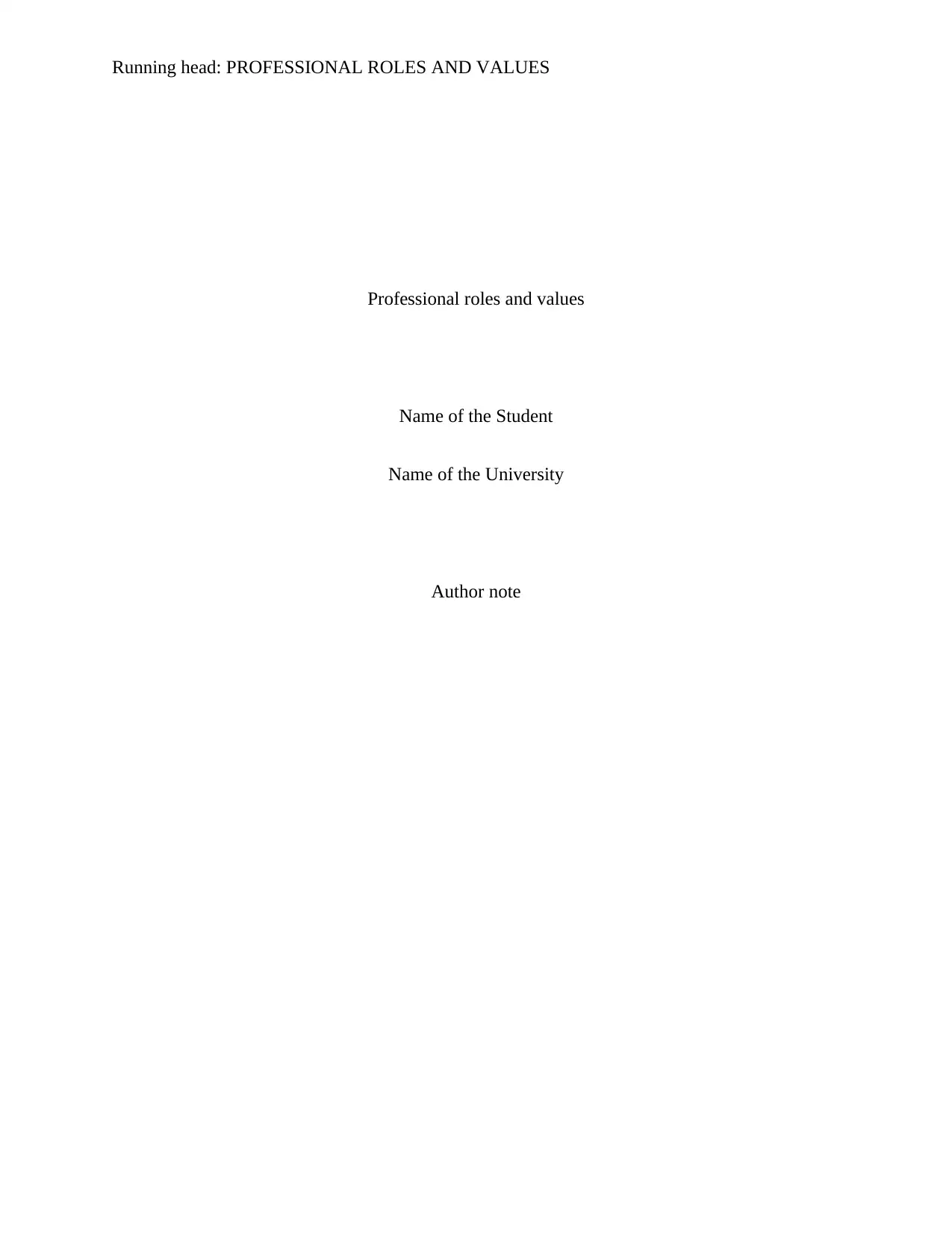
Running head: PROFESSIONAL ROLES AND VALUES
Professional roles and values
Name of the Student
Name of the University
Author note
Professional roles and values
Name of the Student
Name of the University
Author note
Paraphrase This Document
Need a fresh take? Get an instant paraphrase of this document with our AI Paraphraser
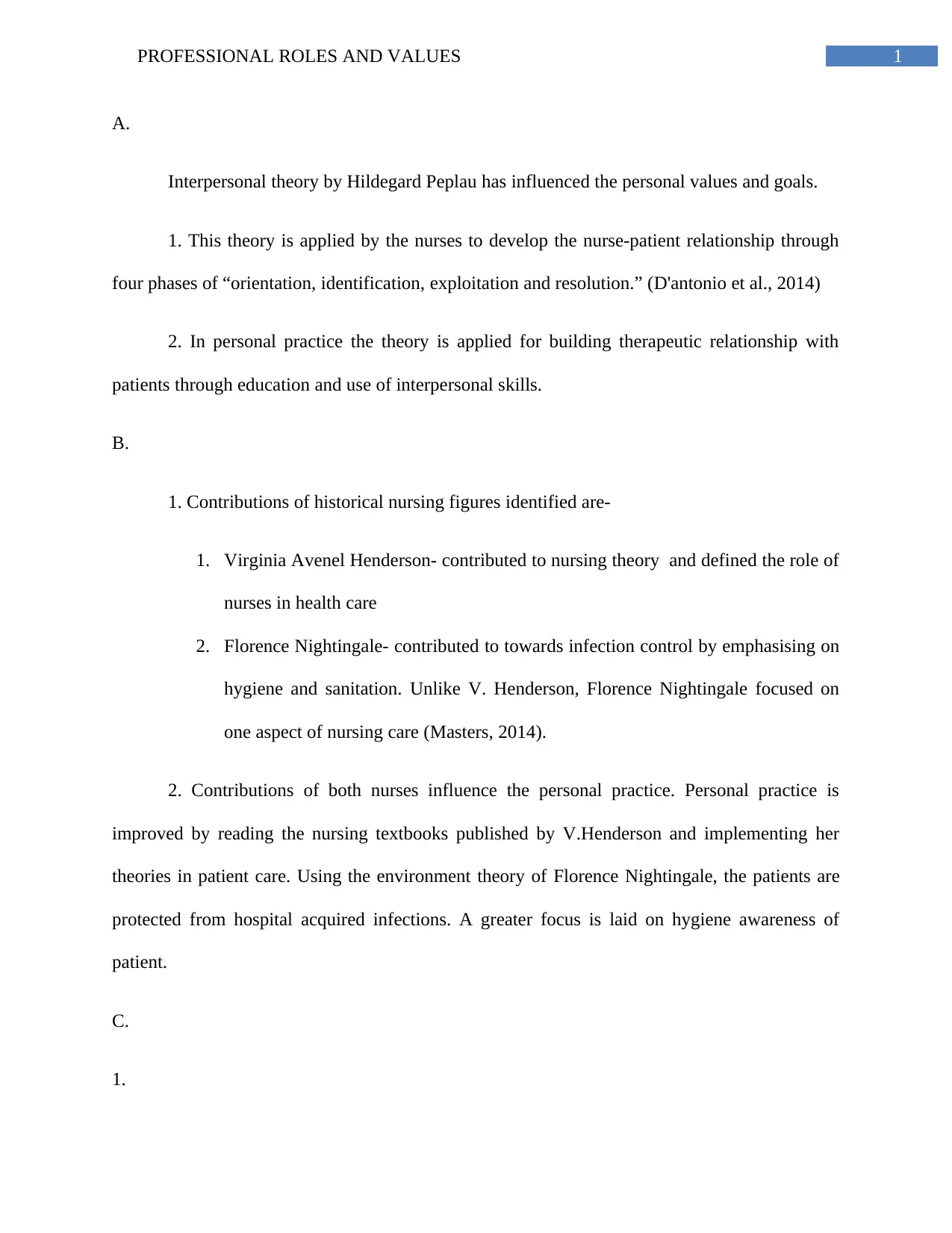
1PROFESSIONAL ROLES AND VALUES
A.
Interpersonal theory by Hildegard Peplau has influenced the personal values and goals.
1. This theory is applied by the nurses to develop the nurse-patient relationship through
four phases of “orientation, identification, exploitation and resolution.” (D'antonio et al., 2014)
2. In personal practice the theory is applied for building therapeutic relationship with
patients through education and use of interpersonal skills.
B.
1. Contributions of historical nursing figures identified are-
1. Virginia Avenel Henderson- contributed to nursing theory and defined the role of
nurses in health care
2. Florence Nightingale- contributed to towards infection control by emphasising on
hygiene and sanitation. Unlike V. Henderson, Florence Nightingale focused on
one aspect of nursing care (Masters, 2014).
2. Contributions of both nurses influence the personal practice. Personal practice is
improved by reading the nursing textbooks published by V.Henderson and implementing her
theories in patient care. Using the environment theory of Florence Nightingale, the patients are
protected from hospital acquired infections. A greater focus is laid on hygiene awareness of
patient.
C.
1.
A.
Interpersonal theory by Hildegard Peplau has influenced the personal values and goals.
1. This theory is applied by the nurses to develop the nurse-patient relationship through
four phases of “orientation, identification, exploitation and resolution.” (D'antonio et al., 2014)
2. In personal practice the theory is applied for building therapeutic relationship with
patients through education and use of interpersonal skills.
B.
1. Contributions of historical nursing figures identified are-
1. Virginia Avenel Henderson- contributed to nursing theory and defined the role of
nurses in health care
2. Florence Nightingale- contributed to towards infection control by emphasising on
hygiene and sanitation. Unlike V. Henderson, Florence Nightingale focused on
one aspect of nursing care (Masters, 2014).
2. Contributions of both nurses influence the personal practice. Personal practice is
improved by reading the nursing textbooks published by V.Henderson and implementing her
theories in patient care. Using the environment theory of Florence Nightingale, the patients are
protected from hospital acquired infections. A greater focus is laid on hygiene awareness of
patient.
C.
1.
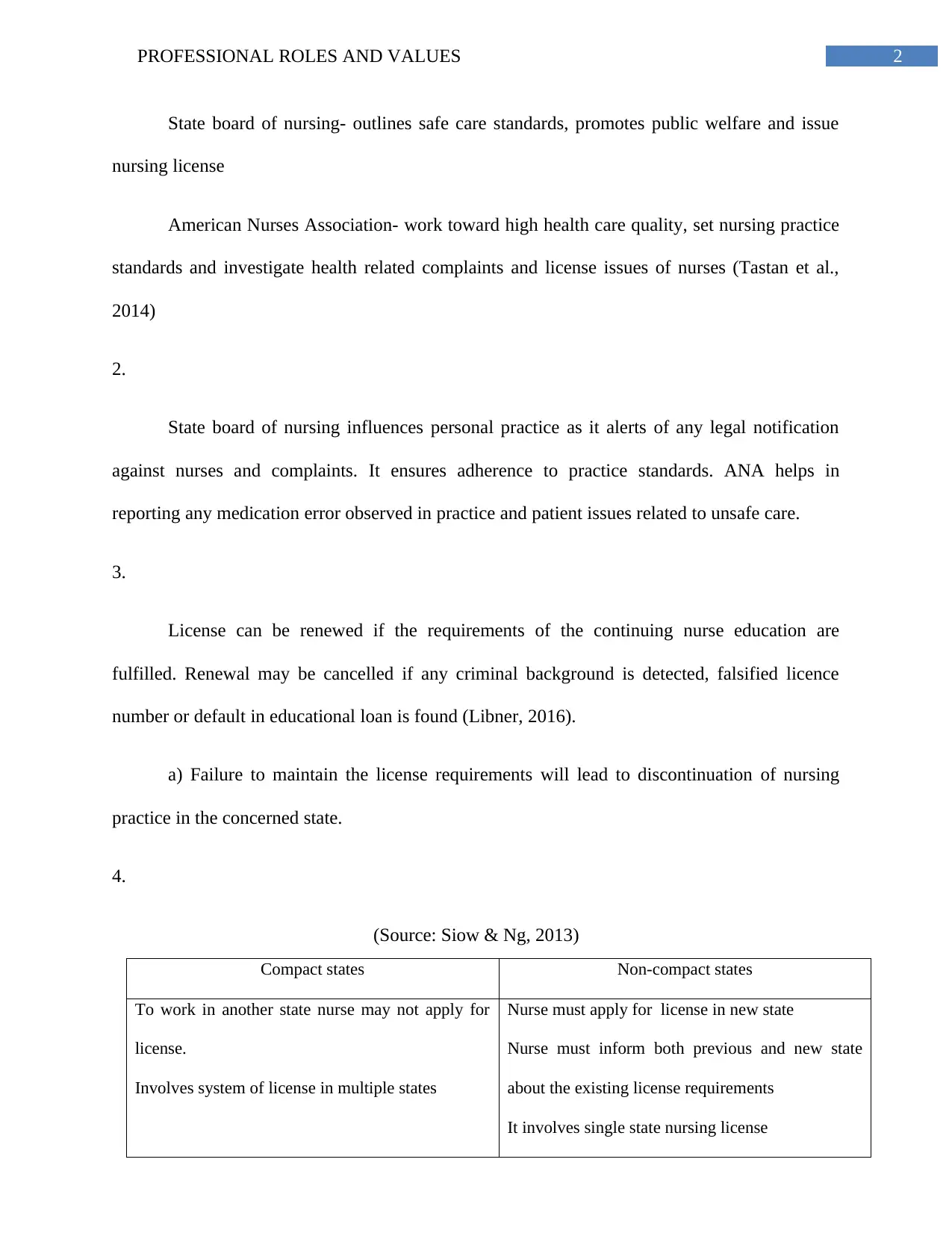
2PROFESSIONAL ROLES AND VALUES
State board of nursing- outlines safe care standards, promotes public welfare and issue
nursing license
American Nurses Association- work toward high health care quality, set nursing practice
standards and investigate health related complaints and license issues of nurses (Tastan et al.,
2014)
2.
State board of nursing influences personal practice as it alerts of any legal notification
against nurses and complaints. It ensures adherence to practice standards. ANA helps in
reporting any medication error observed in practice and patient issues related to unsafe care.
3.
License can be renewed if the requirements of the continuing nurse education are
fulfilled. Renewal may be cancelled if any criminal background is detected, falsified licence
number or default in educational loan is found (Libner, 2016).
a) Failure to maintain the license requirements will lead to discontinuation of nursing
practice in the concerned state.
4.
(Source: Siow & Ng, 2013)
Compact states Non-compact states
To work in another state nurse may not apply for
license.
Involves system of license in multiple states
Nurse must apply for license in new state
Nurse must inform both previous and new state
about the existing license requirements
It involves single state nursing license
State board of nursing- outlines safe care standards, promotes public welfare and issue
nursing license
American Nurses Association- work toward high health care quality, set nursing practice
standards and investigate health related complaints and license issues of nurses (Tastan et al.,
2014)
2.
State board of nursing influences personal practice as it alerts of any legal notification
against nurses and complaints. It ensures adherence to practice standards. ANA helps in
reporting any medication error observed in practice and patient issues related to unsafe care.
3.
License can be renewed if the requirements of the continuing nurse education are
fulfilled. Renewal may be cancelled if any criminal background is detected, falsified licence
number or default in educational loan is found (Libner, 2016).
a) Failure to maintain the license requirements will lead to discontinuation of nursing
practice in the concerned state.
4.
(Source: Siow & Ng, 2013)
Compact states Non-compact states
To work in another state nurse may not apply for
license.
Involves system of license in multiple states
Nurse must apply for license in new state
Nurse must inform both previous and new state
about the existing license requirements
It involves single state nursing license
⊘ This is a preview!⊘
Do you want full access?
Subscribe today to unlock all pages.

Trusted by 1+ million students worldwide
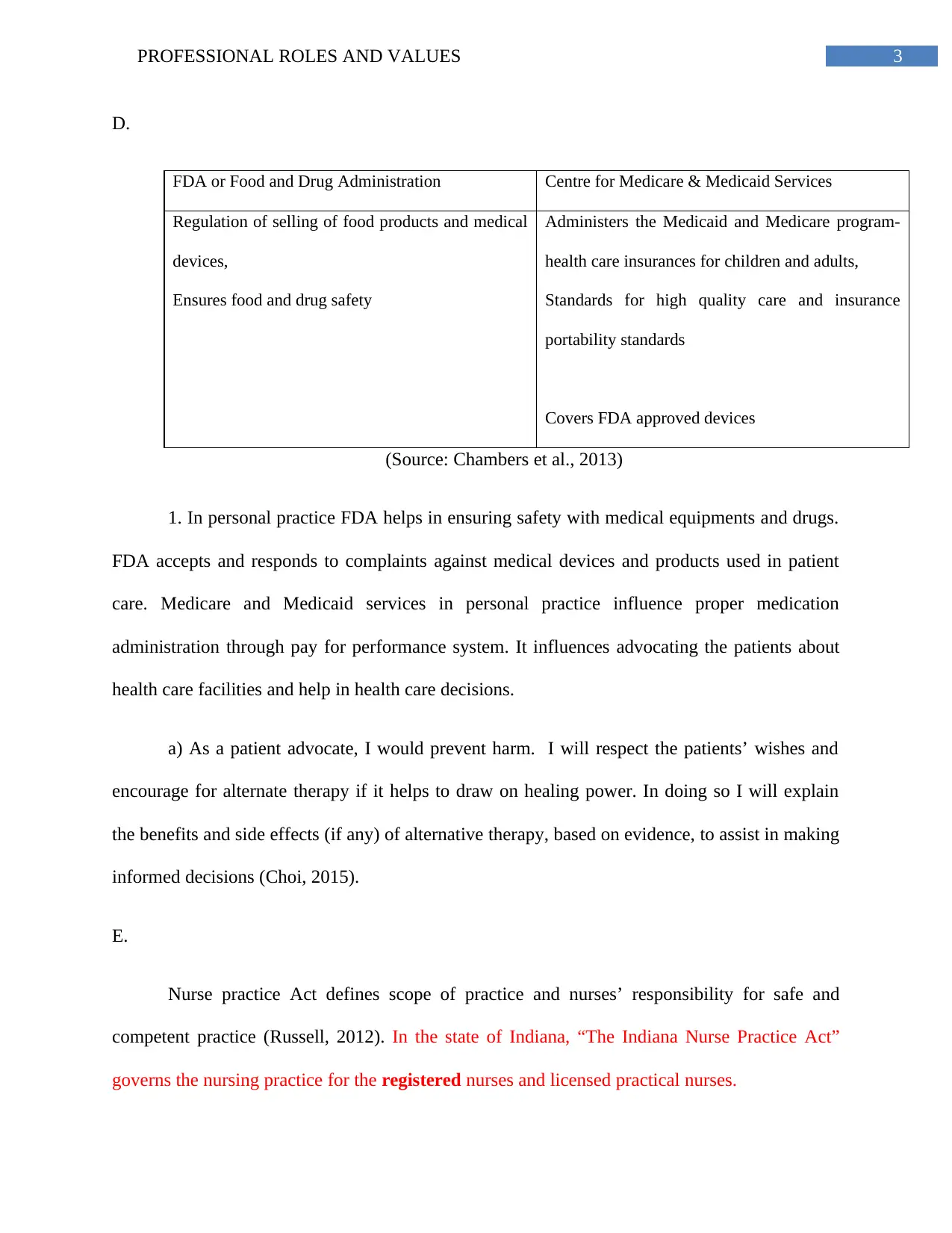
3PROFESSIONAL ROLES AND VALUES
D.
FDA or Food and Drug Administration Centre for Medicare & Medicaid Services
Regulation of selling of food products and medical
devices,
Ensures food and drug safety
Administers the Medicaid and Medicare program-
health care insurances for children and adults,
Standards for high quality care and insurance
portability standards
Covers FDA approved devices
(Source: Chambers et al., 2013)
1. In personal practice FDA helps in ensuring safety with medical equipments and drugs.
FDA accepts and responds to complaints against medical devices and products used in patient
care. Medicare and Medicaid services in personal practice influence proper medication
administration through pay for performance system. It influences advocating the patients about
health care facilities and help in health care decisions.
a) As a patient advocate, I would prevent harm. I will respect the patients’ wishes and
encourage for alternate therapy if it helps to draw on healing power. In doing so I will explain
the benefits and side effects (if any) of alternative therapy, based on evidence, to assist in making
informed decisions (Choi, 2015).
E.
Nurse practice Act defines scope of practice and nurses’ responsibility for safe and
competent practice (Russell, 2012). In the state of Indiana, “The Indiana Nurse Practice Act”
governs the nursing practice for the registered nurses and licensed practical nurses.
D.
FDA or Food and Drug Administration Centre for Medicare & Medicaid Services
Regulation of selling of food products and medical
devices,
Ensures food and drug safety
Administers the Medicaid and Medicare program-
health care insurances for children and adults,
Standards for high quality care and insurance
portability standards
Covers FDA approved devices
(Source: Chambers et al., 2013)
1. In personal practice FDA helps in ensuring safety with medical equipments and drugs.
FDA accepts and responds to complaints against medical devices and products used in patient
care. Medicare and Medicaid services in personal practice influence proper medication
administration through pay for performance system. It influences advocating the patients about
health care facilities and help in health care decisions.
a) As a patient advocate, I would prevent harm. I will respect the patients’ wishes and
encourage for alternate therapy if it helps to draw on healing power. In doing so I will explain
the benefits and side effects (if any) of alternative therapy, based on evidence, to assist in making
informed decisions (Choi, 2015).
E.
Nurse practice Act defines scope of practice and nurses’ responsibility for safe and
competent practice (Russell, 2012). In the state of Indiana, “The Indiana Nurse Practice Act”
governs the nursing practice for the registered nurses and licensed practical nurses.
Paraphrase This Document
Need a fresh take? Get an instant paraphrase of this document with our AI Paraphraser
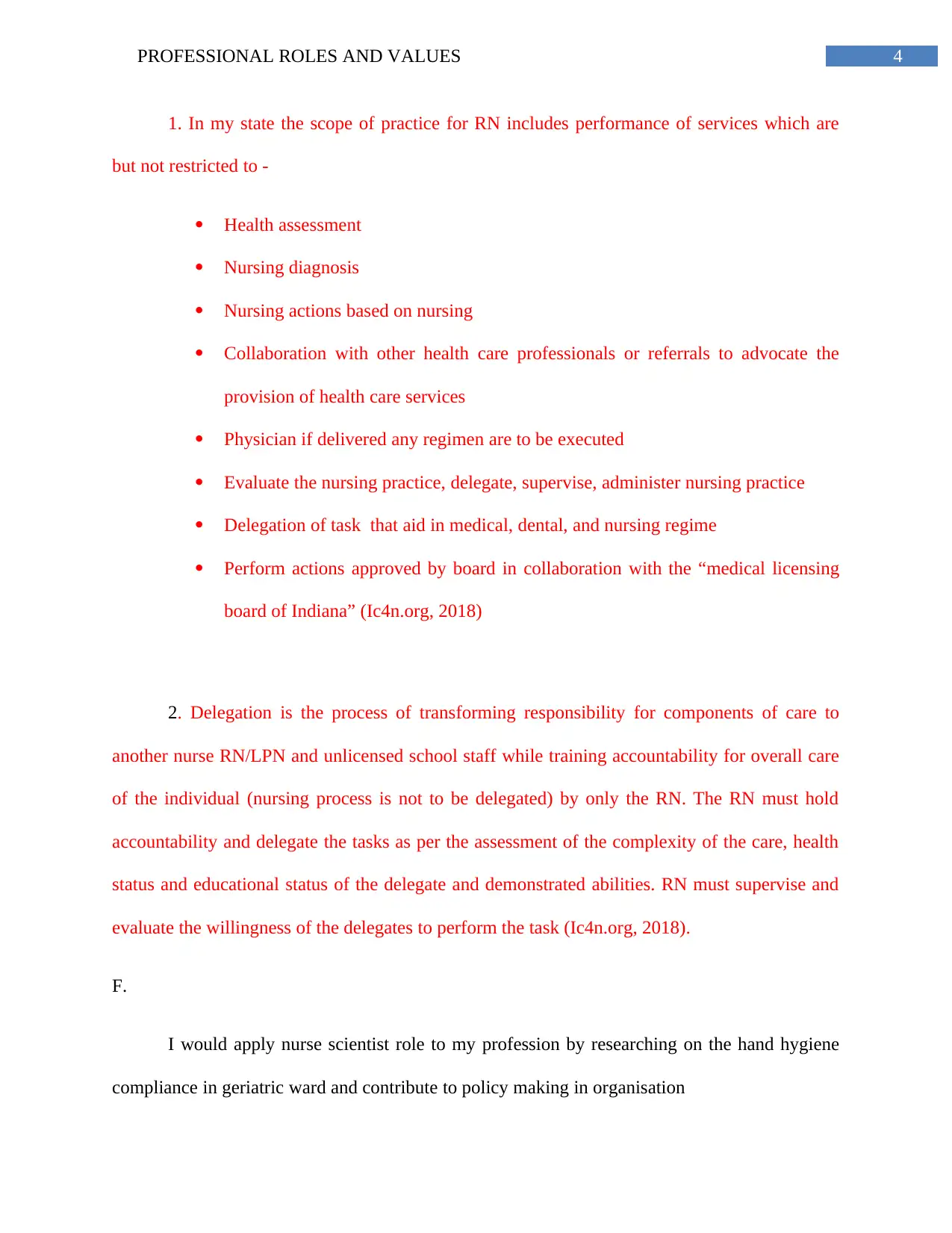
4PROFESSIONAL ROLES AND VALUES
1. In my state the scope of practice for RN includes performance of services which are
but not restricted to -
Health assessment
Nursing diagnosis
Nursing actions based on nursing
Collaboration with other health care professionals or referrals to advocate the
provision of health care services
Physician if delivered any regimen are to be executed
Evaluate the nursing practice, delegate, supervise, administer nursing practice
Delegation of task that aid in medical, dental, and nursing regime
Perform actions approved by board in collaboration with the “medical licensing
board of Indiana” (Ic4n.org, 2018)
2. Delegation is the process of transforming responsibility for components of care to
another nurse RN/LPN and unlicensed school staff while training accountability for overall care
of the individual (nursing process is not to be delegated) by only the RN. The RN must hold
accountability and delegate the tasks as per the assessment of the complexity of the care, health
status and educational status of the delegate and demonstrated abilities. RN must supervise and
evaluate the willingness of the delegates to perform the task (Ic4n.org, 2018).
F.
I would apply nurse scientist role to my profession by researching on the hand hygiene
compliance in geriatric ward and contribute to policy making in organisation
1. In my state the scope of practice for RN includes performance of services which are
but not restricted to -
Health assessment
Nursing diagnosis
Nursing actions based on nursing
Collaboration with other health care professionals or referrals to advocate the
provision of health care services
Physician if delivered any regimen are to be executed
Evaluate the nursing practice, delegate, supervise, administer nursing practice
Delegation of task that aid in medical, dental, and nursing regime
Perform actions approved by board in collaboration with the “medical licensing
board of Indiana” (Ic4n.org, 2018)
2. Delegation is the process of transforming responsibility for components of care to
another nurse RN/LPN and unlicensed school staff while training accountability for overall care
of the individual (nursing process is not to be delegated) by only the RN. The RN must hold
accountability and delegate the tasks as per the assessment of the complexity of the care, health
status and educational status of the delegate and demonstrated abilities. RN must supervise and
evaluate the willingness of the delegates to perform the task (Ic4n.org, 2018).
F.
I would apply nurse scientist role to my profession by researching on the hand hygiene
compliance in geriatric ward and contribute to policy making in organisation
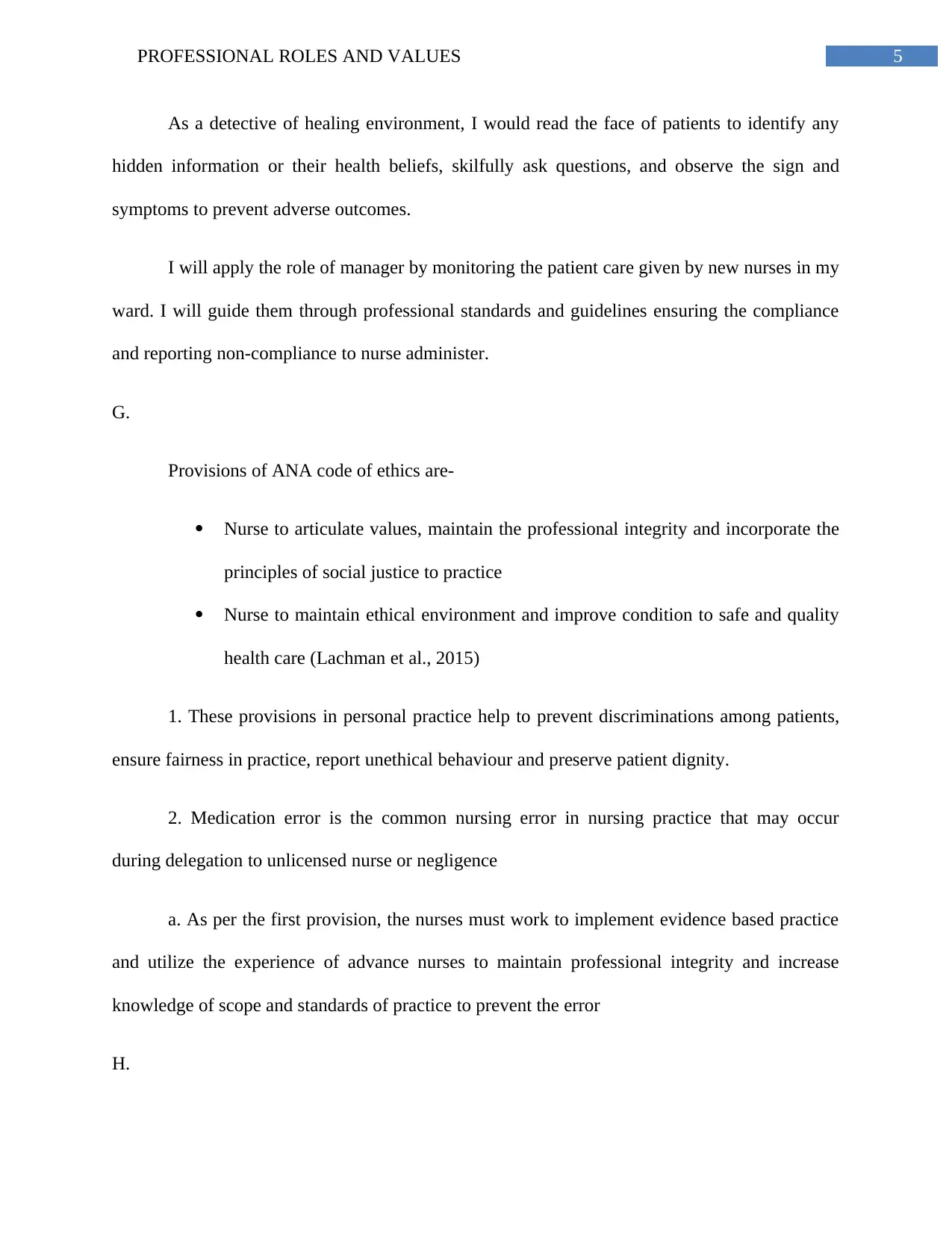
5PROFESSIONAL ROLES AND VALUES
As a detective of healing environment, I would read the face of patients to identify any
hidden information or their health beliefs, skilfully ask questions, and observe the sign and
symptoms to prevent adverse outcomes.
I will apply the role of manager by monitoring the patient care given by new nurses in my
ward. I will guide them through professional standards and guidelines ensuring the compliance
and reporting non-compliance to nurse administer.
G.
Provisions of ANA code of ethics are-
Nurse to articulate values, maintain the professional integrity and incorporate the
principles of social justice to practice
Nurse to maintain ethical environment and improve condition to safe and quality
health care (Lachman et al., 2015)
1. These provisions in personal practice help to prevent discriminations among patients,
ensure fairness in practice, report unethical behaviour and preserve patient dignity.
2. Medication error is the common nursing error in nursing practice that may occur
during delegation to unlicensed nurse or negligence
a. As per the first provision, the nurses must work to implement evidence based practice
and utilize the experience of advance nurses to maintain professional integrity and increase
knowledge of scope and standards of practice to prevent the error
H.
As a detective of healing environment, I would read the face of patients to identify any
hidden information or their health beliefs, skilfully ask questions, and observe the sign and
symptoms to prevent adverse outcomes.
I will apply the role of manager by monitoring the patient care given by new nurses in my
ward. I will guide them through professional standards and guidelines ensuring the compliance
and reporting non-compliance to nurse administer.
G.
Provisions of ANA code of ethics are-
Nurse to articulate values, maintain the professional integrity and incorporate the
principles of social justice to practice
Nurse to maintain ethical environment and improve condition to safe and quality
health care (Lachman et al., 2015)
1. These provisions in personal practice help to prevent discriminations among patients,
ensure fairness in practice, report unethical behaviour and preserve patient dignity.
2. Medication error is the common nursing error in nursing practice that may occur
during delegation to unlicensed nurse or negligence
a. As per the first provision, the nurses must work to implement evidence based practice
and utilize the experience of advance nurses to maintain professional integrity and increase
knowledge of scope and standards of practice to prevent the error
H.
⊘ This is a preview!⊘
Do you want full access?
Subscribe today to unlock all pages.

Trusted by 1+ million students worldwide
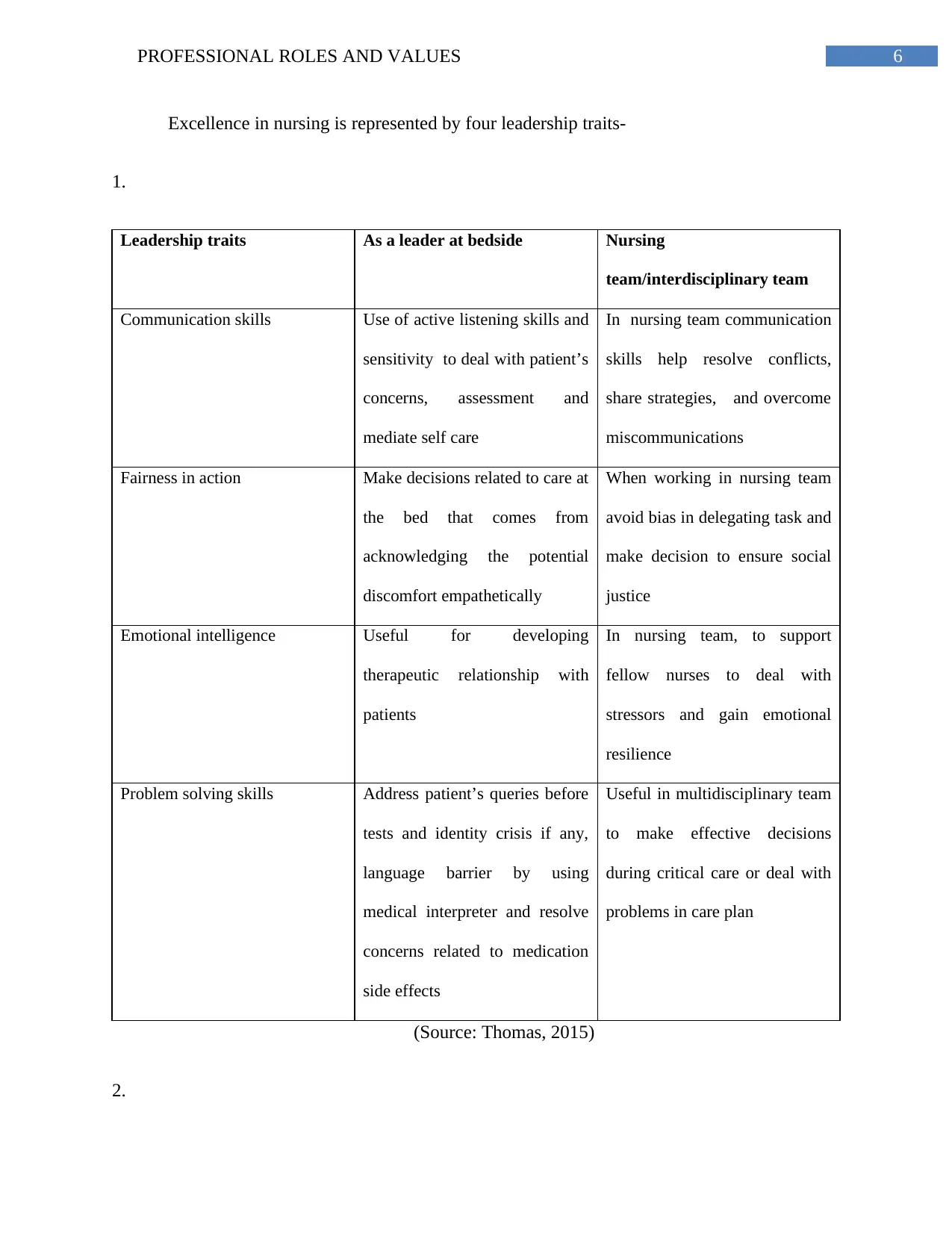
6PROFESSIONAL ROLES AND VALUES
Excellence in nursing is represented by four leadership traits-
1.
Leadership traits As a leader at bedside Nursing
team/interdisciplinary team
Communication skills Use of active listening skills and
sensitivity to deal with patient’s
concerns, assessment and
mediate self care
In nursing team communication
skills help resolve conflicts,
share strategies, and overcome
miscommunications
Fairness in action Make decisions related to care at
the bed that comes from
acknowledging the potential
discomfort empathetically
When working in nursing team
avoid bias in delegating task and
make decision to ensure social
justice
Emotional intelligence Useful for developing
therapeutic relationship with
patients
In nursing team, to support
fellow nurses to deal with
stressors and gain emotional
resilience
Problem solving skills Address patient’s queries before
tests and identity crisis if any,
language barrier by using
medical interpreter and resolve
concerns related to medication
side effects
Useful in multidisciplinary team
to make effective decisions
during critical care or deal with
problems in care plan
(Source: Thomas, 2015)
2.
Excellence in nursing is represented by four leadership traits-
1.
Leadership traits As a leader at bedside Nursing
team/interdisciplinary team
Communication skills Use of active listening skills and
sensitivity to deal with patient’s
concerns, assessment and
mediate self care
In nursing team communication
skills help resolve conflicts,
share strategies, and overcome
miscommunications
Fairness in action Make decisions related to care at
the bed that comes from
acknowledging the potential
discomfort empathetically
When working in nursing team
avoid bias in delegating task and
make decision to ensure social
justice
Emotional intelligence Useful for developing
therapeutic relationship with
patients
In nursing team, to support
fellow nurses to deal with
stressors and gain emotional
resilience
Problem solving skills Address patient’s queries before
tests and identity crisis if any,
language barrier by using
medical interpreter and resolve
concerns related to medication
side effects
Useful in multidisciplinary team
to make effective decisions
during critical care or deal with
problems in care plan
(Source: Thomas, 2015)
2.
Paraphrase This Document
Need a fresh take? Get an instant paraphrase of this document with our AI Paraphraser
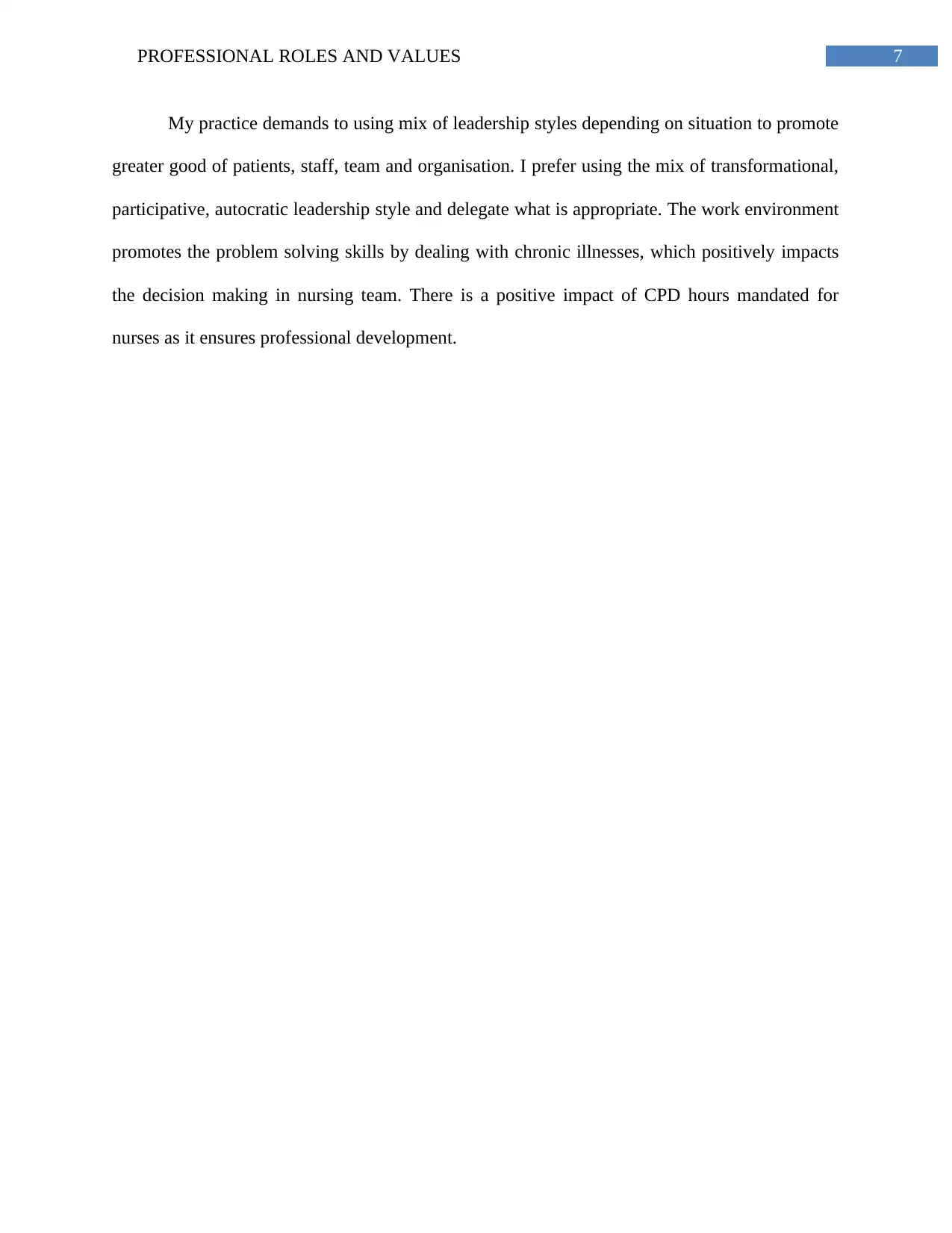
7PROFESSIONAL ROLES AND VALUES
My practice demands to using mix of leadership styles depending on situation to promote
greater good of patients, staff, team and organisation. I prefer using the mix of transformational,
participative, autocratic leadership style and delegate what is appropriate. The work environment
promotes the problem solving skills by dealing with chronic illnesses, which positively impacts
the decision making in nursing team. There is a positive impact of CPD hours mandated for
nurses as it ensures professional development.
My practice demands to using mix of leadership styles depending on situation to promote
greater good of patients, staff, team and organisation. I prefer using the mix of transformational,
participative, autocratic leadership style and delegate what is appropriate. The work environment
promotes the problem solving skills by dealing with chronic illnesses, which positively impacts
the decision making in nursing team. There is a positive impact of CPD hours mandated for
nurses as it ensures professional development.
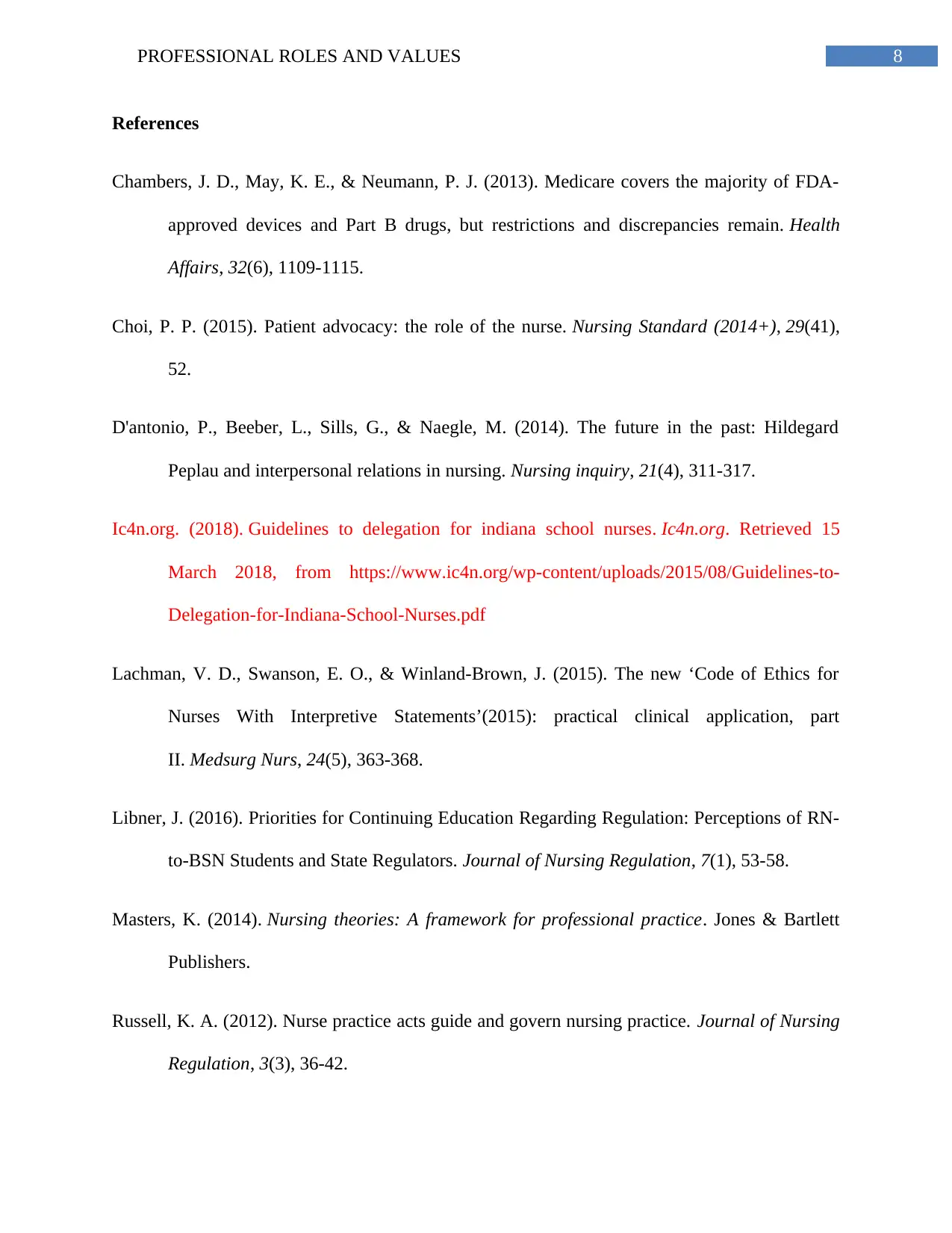
8PROFESSIONAL ROLES AND VALUES
References
Chambers, J. D., May, K. E., & Neumann, P. J. (2013). Medicare covers the majority of FDA-
approved devices and Part B drugs, but restrictions and discrepancies remain. Health
Affairs, 32(6), 1109-1115.
Choi, P. P. (2015). Patient advocacy: the role of the nurse. Nursing Standard (2014+), 29(41),
52.
D'antonio, P., Beeber, L., Sills, G., & Naegle, M. (2014). The future in the past: Hildegard
Peplau and interpersonal relations in nursing. Nursing inquiry, 21(4), 311-317.
Ic4n.org. (2018). Guidelines to delegation for indiana school nurses. Ic4n.org. Retrieved 15
March 2018, from https://www.ic4n.org/wp-content/uploads/2015/08/Guidelines-to-
Delegation-for-Indiana-School-Nurses.pdf
Lachman, V. D., Swanson, E. O., & Winland-Brown, J. (2015). The new ‘Code of Ethics for
Nurses With Interpretive Statements’(2015): practical clinical application, part
II. Medsurg Nurs, 24(5), 363-368.
Libner, J. (2016). Priorities for Continuing Education Regarding Regulation: Perceptions of RN-
to-BSN Students and State Regulators. Journal of Nursing Regulation, 7(1), 53-58.
Masters, K. (2014). Nursing theories: A framework for professional practice. Jones & Bartlett
Publishers.
Russell, K. A. (2012). Nurse practice acts guide and govern nursing practice. Journal of Nursing
Regulation, 3(3), 36-42.
References
Chambers, J. D., May, K. E., & Neumann, P. J. (2013). Medicare covers the majority of FDA-
approved devices and Part B drugs, but restrictions and discrepancies remain. Health
Affairs, 32(6), 1109-1115.
Choi, P. P. (2015). Patient advocacy: the role of the nurse. Nursing Standard (2014+), 29(41),
52.
D'antonio, P., Beeber, L., Sills, G., & Naegle, M. (2014). The future in the past: Hildegard
Peplau and interpersonal relations in nursing. Nursing inquiry, 21(4), 311-317.
Ic4n.org. (2018). Guidelines to delegation for indiana school nurses. Ic4n.org. Retrieved 15
March 2018, from https://www.ic4n.org/wp-content/uploads/2015/08/Guidelines-to-
Delegation-for-Indiana-School-Nurses.pdf
Lachman, V. D., Swanson, E. O., & Winland-Brown, J. (2015). The new ‘Code of Ethics for
Nurses With Interpretive Statements’(2015): practical clinical application, part
II. Medsurg Nurs, 24(5), 363-368.
Libner, J. (2016). Priorities for Continuing Education Regarding Regulation: Perceptions of RN-
to-BSN Students and State Regulators. Journal of Nursing Regulation, 7(1), 53-58.
Masters, K. (2014). Nursing theories: A framework for professional practice. Jones & Bartlett
Publishers.
Russell, K. A. (2012). Nurse practice acts guide and govern nursing practice. Journal of Nursing
Regulation, 3(3), 36-42.
⊘ This is a preview!⊘
Do you want full access?
Subscribe today to unlock all pages.

Trusted by 1+ million students worldwide
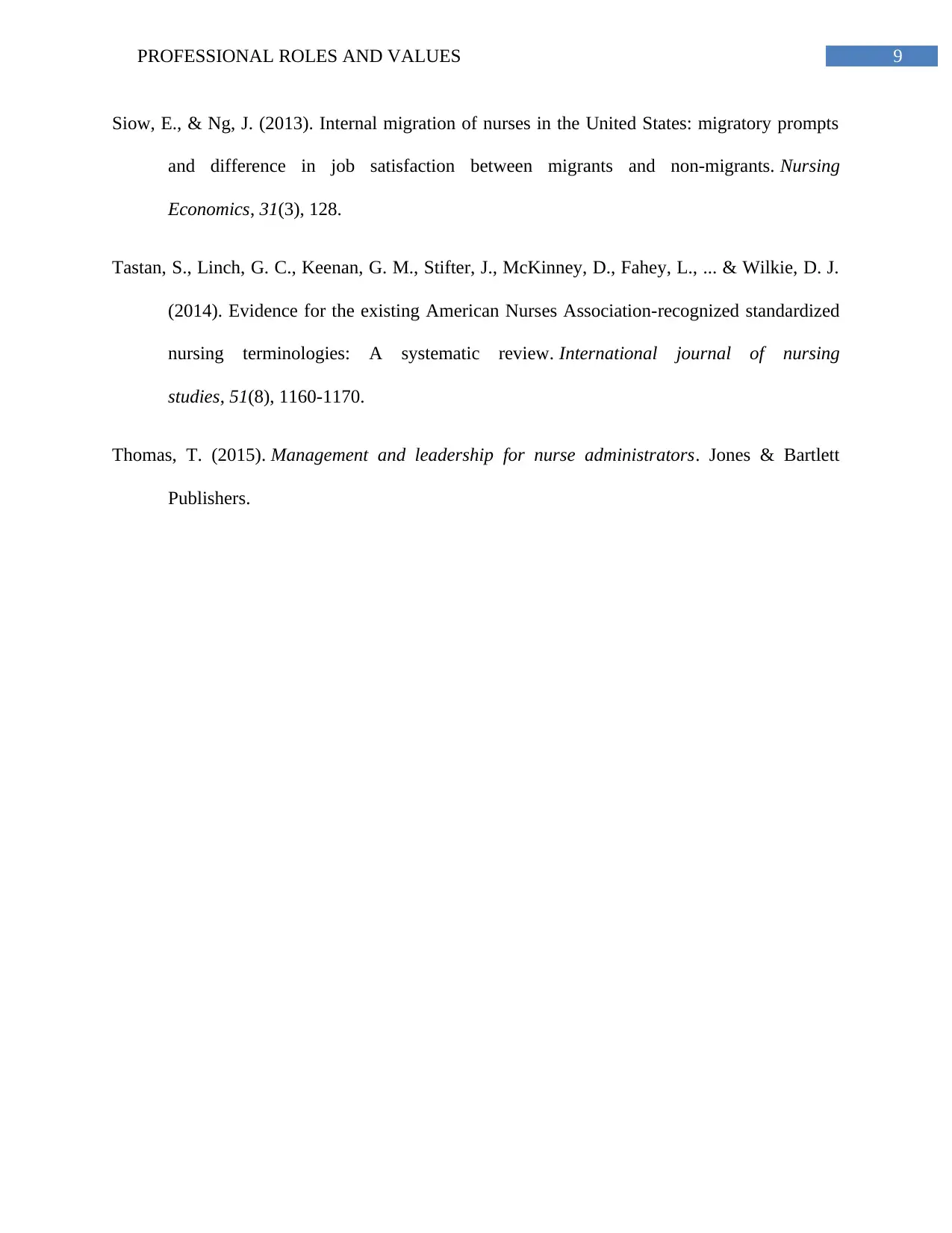
9PROFESSIONAL ROLES AND VALUES
Siow, E., & Ng, J. (2013). Internal migration of nurses in the United States: migratory prompts
and difference in job satisfaction between migrants and non-migrants. Nursing
Economics, 31(3), 128.
Tastan, S., Linch, G. C., Keenan, G. M., Stifter, J., McKinney, D., Fahey, L., ... & Wilkie, D. J.
(2014). Evidence for the existing American Nurses Association-recognized standardized
nursing terminologies: A systematic review. International journal of nursing
studies, 51(8), 1160-1170.
Thomas, T. (2015). Management and leadership for nurse administrators. Jones & Bartlett
Publishers.
Siow, E., & Ng, J. (2013). Internal migration of nurses in the United States: migratory prompts
and difference in job satisfaction between migrants and non-migrants. Nursing
Economics, 31(3), 128.
Tastan, S., Linch, G. C., Keenan, G. M., Stifter, J., McKinney, D., Fahey, L., ... & Wilkie, D. J.
(2014). Evidence for the existing American Nurses Association-recognized standardized
nursing terminologies: A systematic review. International journal of nursing
studies, 51(8), 1160-1170.
Thomas, T. (2015). Management and leadership for nurse administrators. Jones & Bartlett
Publishers.
1 out of 10
Related Documents
Your All-in-One AI-Powered Toolkit for Academic Success.
+13062052269
info@desklib.com
Available 24*7 on WhatsApp / Email
![[object Object]](/_next/static/media/star-bottom.7253800d.svg)
Unlock your academic potential
Copyright © 2020–2025 A2Z Services. All Rights Reserved. Developed and managed by ZUCOL.





